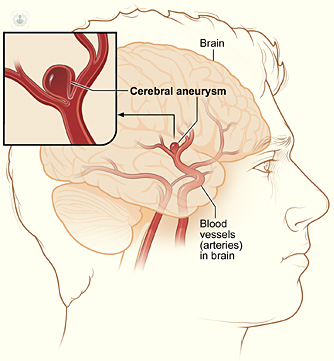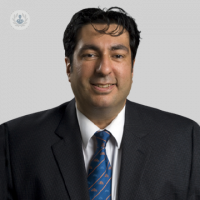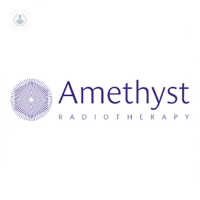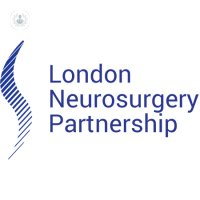Brain aneurysm
What is a brain aneurysm?
A brain aneurysm is a cerebrovascular disease that develops due to a dilatation (weakness) of the arterial blood vessel wall in the brain, usually where the vessel branches. As blood flows through the blood vessel, the pressure causes the weak point of the blood vessel to bulge outwards, like a balloon. It is estimated that five per cent of the population have an unruptured aneurysm, but they rarely produce any symptoms.
Due to its thin walls, all aneurysms run the risk of rupturing (bursting), causing internal bleeding into the space between the skull and the brain. This is an extremely dangerous situation called a subarachnoid haemorrhage, a form of haemorrhagic stroke (also called brain bleed). A haemorrhagic stroke is the most disabling type of stroke which can cause irreversible nerve and brain damage.

The different types of brain aneurysms
Aneurysms are classified according to their size and shape. They can be saccular, fusiform, and lateral:
- Saccular aneurysm: the most common type, saccular aneurysms make up 90 per cent of brain aneurysms. They are attached by a small stem to the main artery or to one of the branches, and have a shape similar to a berry's.
- Fusiform aneurysm: a less frequent type, which looks like the blood vessel expanding on all sides of the artery. Fusiform aneurysms are usually associated with atherosclerosis.
- Lateral aneurysm: a rare type, which balloons out only in one side of the artery wall.
Approximately 10 to 30 per cent of patients will have more than one aneurysm.
What are the symptoms?
Aneurysms tend to be asymptomatic and only manifest when they get bigger, filter blood, or rupture, causing:
- sudden, agonising headaches
- nausea and vomiting
- neck stiffness
- seizures
- sudden loss of consciousness
- sensitivity to light
If the aneurysm is putting pressure on the nerves, it could cause dropping eyelid, double vision, dilated pupils, pain above or behind the eye, and numbness or weakness on one side of the face or body.
How is a brain aneurysm diagnosed?
Tests such as an angiography or a CT scan are used to diagnose a brain aneurysm.
An angiography will find any blockage and weak spots in the arteries where an aneurysm could have developed. The test will also create a detailed image of the aneurysm's appearance and detect the cause of the brain bleeding.
A CT scan will show the size, location and shape of the aneurysm and reveal whether blood has leaked into the brain.
What causes it?
A brain aneurysm may develop due to congenital factors, head trauma, a tumour, atherosclerosis, an infection or regular consumption of toxic substances.
Bulges that end up causing brain aneurysms cause weakness in the blood vessel walls which leads to an increase in size, which entails a risk of rupture and extensive internal haemorrhage.
The main risk factors that contribute to the formation of a brain aneurysm are:
- hypertension
- smoking
- family history
- central nervous system or brain infections which cause inflammation
- weakness in the blood vessel walls from birth
- alcohol and drug use
- polycystic kidney disease
Brain aneurysms can occur at any age, although they are rare in children. They are more frequent in people who are over 40 years old. Women are more likely to be affected.
How can it be prevented?
The best way to prevent brain aneurysms is to control cardiovascular risk factors and conditions that weaken blood vessels, such as diabetes, cholesterol and atherosclerosis, as well as maintaining a healthy lifestyle and avoiding stress, tobacco and alcohol use.
If - and when - an aneurysm is found, ultrasound scans should be performed regularly (every six months for example) to monitor its potential growth. Medication may also be prescribed to decrease your blood pressure.
If your parents or siblings have had a brain aneurysm, you may also be at risk of developing one. Aneurysm screening with a CT scan or an MRI to look at the brain's arteries, may be recommended.
What is the treatment?
Treatment will depend on whether the aneurysm is intact or ruptured. The majority of aneurysms do not rupture so treatment is also carried out if there is a high risk of rupture. This will be determined by your age, the size of the aneurysm, the location of the aneurysm and other pre-existing health conditions.
In the case of an intact aneurysm, an aneurysm clipping (also known as a microvascular clipping) or an endovascular repair (the injured vessel is repaired) will be performed.
In an aneurysm clipping, a small titanium clip is placed during a craniotomy (an open surgical procedure to expose the brain) over the blood vessel that feeds the aneurysm. This seals the aneurysm's neck, cutting off blood supply to the aneurysm. Without blood, the aneurysm cannot grow or rupture. Large aneurysms or those that involve a large section of the blood vessel may need clips on either side of the aneurysm, or a bypass around the aneurysm. Modern aneurysm clips are usually MRI-safe, but you should still check if your clip is compatible before undergoing any MRI scan.
In an endovascular repair, a catheter is inserted into an artery (usually in the wrist or groin) and threaded through the body into the aneurysm. Small platinum detached coils, stents, flow diverters or balloons are then inserted into the aneurysm through a tube, stopping blood flow from entering the aneurysm. The aneurysm is sealed off, preventing its rupture.
If the aneurysm has ruptured, immediate treatment is necessary which may require hospitalisation in the intensive care unit and the administration of medication to lower the risk of cerebral ischemia (severe disruption of blood supply to the brain) as well as complete bed rest, cerebral ventricular damage and drugs.
You may need to stay up to four weeks in hospital to recover, depending on the extent of brain injury caused by the aneurysm, your health and your response to treatment. Follow-up tests will be done three to five days after treatment to analyse its effectiveness. Rehabilitation will be considered then, if needed.
What is the prognosis of a brain aneurysm?
Ruptured brain aneurysms that have caused subarachnoid haemorrhage are fatal in more than half of the cases. Of those who survive, half of patients have a severe, neurological brain damage and disability.
A burst brain aneurysm is is a medical emergency which requires immediate medical attention. Call an ambulance as soon as you or someone else experiences any symptoms that could be caused by a brain aneurysm.
Can a brain aneurysm cause personality changes?
Some people may experience social and emotional changes after a brain aneurysm is detected, due to injury to the frontal lobe (responsible for regulating emotions) and due to the changes that occur after a brain injury, such as loss of job, disabilities, financial problems and physical limitations.
Changes can include:
- Loss of control over emotions: this can manifest itself as frustration, anger, tearfulness and confusion. It is temporary and symptoms will usually get better with time.
- Changes in self-esteem and relationships: after a brain aneurysm, you may require adjusting to the new changes in your day-to-day life. As a result, you may notice changes in your relationship with yourself, your family and your friends, which will return to normal as you slowly recover.
- Isolation: due to the aneurysm treatment, you may feel distanced from your family members or your friends who might not understand your circumstances completely.
- Depression and anxiety: these are two common conditions that appear after developing an aneurysm which may be caused by the aneurysm or changes in daily lifestyle. Visit a psychologist if you experience symptoms such as sadness, guilt, lethargy, weight changes, self-harm thoughts or disturbed sleep.
Can a brain aneurysm heal itself?
It is extremely rare that a brain aneurysm will disappear or heal by itself without treatment. This could only happen in small aneurysms, where blood flow is so slow that eventually a blood clot develops, naturally sealing off the aneurysm. However, this is very rare.
A neurosurgeon treats a brain aneurysm.










